Home-building completion times continue to reach record highs, delaying critical housing projects and pushing the country’s housing problems further into crisis.
New data from the Australian Bureau of Statistics reveals that building delays are blowing past previous estimates, adding months to home completion times across the country as the housing industry struggles to keep up with demand.
Fifteen years ago, the average build time for a standalone house was about nine months. Fast forward, and that time has stretched to an eye-watering 12.7 months — a jump of over 40 per cent.

For apartment builds, the news is even bleaker, with completion times expanding from an average of 18.5 months to a staggering 33.3 months — marking an 80 per cent increase
Meanwhile, the data also shows a sharp 18 per cent decline in productivity across the construction industry over the past decade, increasing strain on an already-stretched workforce.

Master Builders Association CEO Denita Wawn says these delays are putting further pressure on the industry’s ability to keep up with housing demand, let alone play catch-up.
“With advancements in technology and construction methods, we should be building homes faster, not slower,” Ms Wawn said.
“Productivity is more than an economic buzzword. This data proves what happens in a construction environment without meaningful reform.”
These building blowouts are due to a perfect storm of issues driving these bottlenecks, according to Ms Wawn.
Those within the construction sector say it will take a multipronged approach to alleviate this pressure and bring home completion times back to par.
“There are a range of contributing factors, including labour shortages, declining productivity, union pattern agreements, supply chain disruptions, complex regulatory requirements, occupational certificate backlogs, and critical infrastructure delays,” Ms Wawn said.
Home builds times go through the roof
Master Builders Australia is not the only industry body to express concern about lagging home construction times, with some states seeing build times blow out excessively in a few years.
Western Australia has seen build times double in the past five years alone, while the construction timeframes in the ACT are now twice as long as they were in 2010.
Meanwhile, housing needs in Queensland are 36 per cent behind the required target levels, with an estimated 32,000 annual completions projected out of 50,000 new homes.
Housing Industry Association Executive Director Queensland Michael Roberts says this ongoing slowdown is worsening the current housing shortage and called on governments focus on cutting red tape, slashing taxes, and bolstering resources to aid housing construction.
“For industry to deliver the homes we need, all cylinders have to be firing. We need more detached homes, more multi-residential in duplexes, triplexes, townhouses, terraces and small unit blocks, and we need more unit towers to go ahead as well,” he explained.
“When applications for housing developments are obstructed, the new State Government must involve itself quickly to overcome hurdles, help make projects more viable and get them moving.”
“The NIMBY crew must not be indulged any longer, and productivity needs to be increased if we are to meet our housing targets.”
With both Master Builders and HIA demanding faster approvals, red tape reduction, and streamlined processes, Australia’s construction sector desperately needs reform.
And as more Australians struggle to find or keep a roof over their head than ever before, Roberts says that’s a sentiment likely to be supported by Queenslanders.
“The government needs to hit the ground running to cut red tape and taxes and focus more resources on home construction,” he said.
“When applications for housing developments are obstructed, the new State Government must involve itself quickly to overcome hurdles, help make projects more viable and get them moving.”
“To all those who want to argue against HIA’s position, my response will be straightforward: ‘Sorry, but we need to build more homes,’” he concluded.







